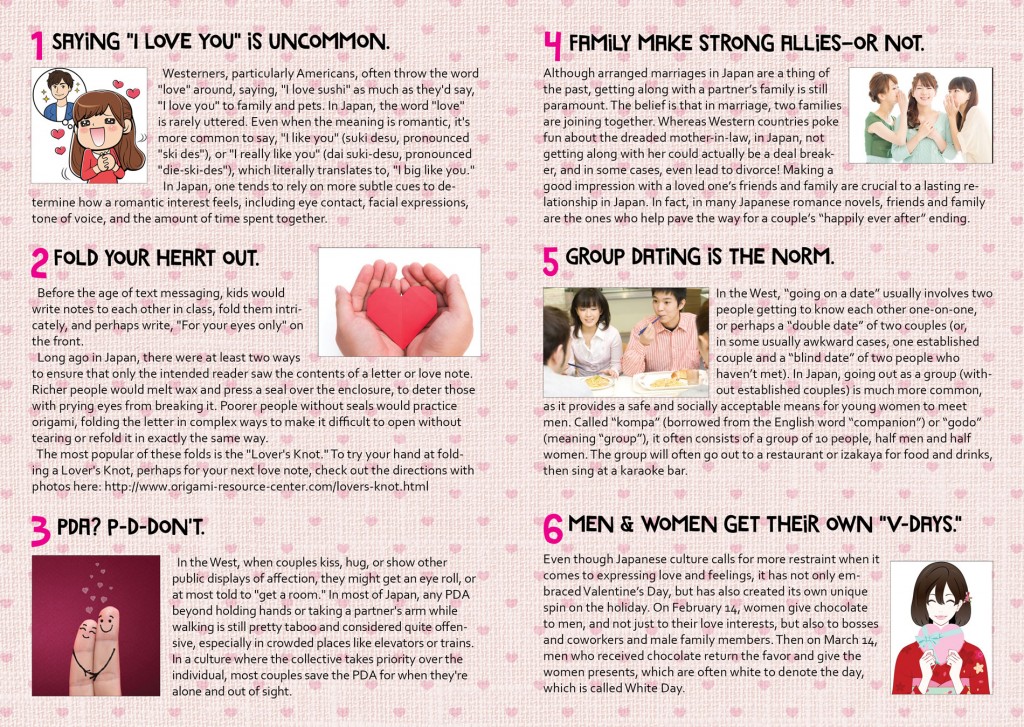Love in Japan
“How do I love thee? Let me count the ways.” So starts the famous sonnet by English poet Elizabeth Barrett Browning. The West is well-known for expressing romantic love in overt ways, in poetry, visual art, and more recently, films and television. Japan, however, is a much older country with strongly held traditions and social rules about romantic love. In Japan, expressing love calls for much subtler demonstrations.
Read on as we discuss some interesting cultural tidbits about romantic love in Japan.
Saying “I Love You” is uncommon
Westerners, particularly Americans, often throw the word “love” around, saying, “I love sushi” as much as they’d say, “I love you” to family and pets. In Japan, the word “love” is rarely uttered. Even when the meaning is romantic, it’s more common to say, “I like you” (suki desu, pronounced “ski des”), or “I really like you” (dai suki-desu, pronounced “die-ski-des”), which literally translates to, “I big like you.”
In Japan, one tends to rely on more subtle cues to determine how a romantic interest feels, including eye contact, facial expressions, tone of voice, and the amount of time spent together.
Fold your heart out
Before the age of text messaging, kids would write notes to each other in class, fold them intricately, and perhaps write, “For your eyes only” on the front.
Long ago in Japan, there were at least two ways to ensure that only the intended reader saw the contents of a letter or love note. Richer people would melt wax and press a seal over the enclosure, to deter those with prying eyes from breaking it. Poorer people without seals would practice origami, folding the letter in complex ways to make it difficult to open without tearing or refold it in exactly the same way.
The most popular of these folds is the “Lover’s Knot.” To try your hand at folding a Lover’s Knot, perhaps for your next love note, check out the directions with photos here: http://www.origami-resource-center.com/lovers-knot.html
PDA? p-d-don’t.
In the West, when couples kiss, hug, or show other public displays of affection, they might get an eye roll, or at most told to “get a room.” In most of Japan, any PDA beyond holding hands or taking a partner’s arm while walking is still pretty taboo and considered quite offensive, especially in crowded places like elevators or trains. In a culture where the collective takes priority over the individual, most couples save the PDA for when they’re alone and out of sight.
Family make strong allies—or not.
Although arranged marriages in Japan are a thing of the past, getting along with a partner’s family is still paramount. The belief is that in marriage, two families are joining together. Whereas Western countries poke fun about the dreaded mother-in-law, in Japan, not getting along with her could actually be a deal breaker, and in some cases, even lead to divorce! Making a good impression with a loved one’s friends and family are crucial to a lasting relationship in Japan. In fact, in many Japanese romance novels, friends and family are the ones who help pave the way for a couple’s “happily ever after” ending.
Group dating is the norm
In the West, “going on a date” usually involves two people getting to know each other one-on-one, or perhaps a “double date” of two couples (or, in some usually awkward cases, one established couple and a “blind date” of two people who haven’t met). In Japan, going out as a group (without established couples) is much more common, as it provides a safe and socially acceptable means for young women to meet men. Called “kompa” (borrowed from the English word “companion”) or “godo” (meaning “group”), it often consists of a group of 10 people, half men and half women. The group will often go out to a restaurant or izakaya for food and drinks, then sing at a karaoke bar.
Men & women get their own “v-days.”
Even though Japanese culture calls for more restraint when it comes to expressing love and feelings, it has not only embraced Valentine’s Day, but has also created its own unique spin on the holiday. On February 14, women give chocolate to men, and not just to their love interests, but also to bosses and coworkers and male family members. Then on March 14, men who received chocolate return the favor and give the women presents, which are often white to denote the day, which is called White Day.
![]()
























